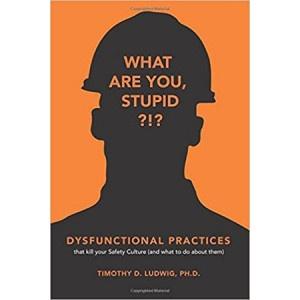Dysfunctional Practices That Kill Your Safety Culture
A man finds himself on the top step of a step ladder; a woman removes the guard to her machine; a worker is not wearing her safety glasses in the plant; a roustabout uses the wrong sized clamp instead of retrieving the right tool from the supply truck; a supervisor teaches a new worker to take short cuts; a mechanic climbs on top of the active machine to find the oil leak. Why do these folks do these things? Is it because they are stupid?
Our tendency is to blame workers and label their personal failings as the cause of safety errors. Labeling does not solve problems that cause error. It is an illusion of human perception leading us to false conclusions resulting in dysfunctional practices that hurt the safety of our workers and the effectiveness of the systems we put in place to protect them. Learn a better way to analyze the behaviors of your employees to understand how they were put in a position to take the risk in the first place.
Dr. Tim Ludwig has over 25 years of experience in research and practice in behavioral safety where he integrates empirical findings into his safety consulting. Within his consulting practice Dr. Ludwig has helped assess, design, and implement safety and quality improvement programs in numerous private and government organizations. He is the author of dozens of scholarly research that empirically document the successes of methods to improve safety and quality in industry through behavior-based solution and has served as editor of the Journal of Organizational Behavior Management and is the past President of the Organizational Behavior Management Network. Dr. Ludwig is a Distinguished Graduate Professor at Appalachian State University where he teaches in the nationally recognized Industrial/Organizational Psychology and Human Resources Management Master’s program.
His popular website SAFETY-DOC.COM is a content-rich resource of safety culture stories, blogs, research, videos, and services. Dr. Ludwig was cited in Industrial Safety and Hygiene News (ISHN) “Power 101” Leaders in the Safety and Health World. Dr. Ludwig serves on the Cambridge Center for Behavioral Studies’ Behavioral Safety Accreditation Commission that reviews best-in-industry safety practices and offers independent, objective feedback on safety programs.
Dysfunctional Practices is a page-turner describing research-based principles of human dynamics in a way you can relate to, understand, and apply. You'll grasp how these principles explain real life events in the workplace – often dysfunctions – and to correct them to prevent injuries.
—Dr. E. Scott Geller
Dysfunctional Practices is one of the most novel and insightful safety books you'll ever pick up. This is not a textbook. It's down to earth, funny, sardonic, at times hear-warming; full of stories and characters, deadly serious and also a bit irreverent, and easy to read.
—Dave Johnson - Editor ISHN
We are witnessing the next generation of thinking on behavioral safety in Dysfunctional Practices. You will learn how programs based on behavioral science succeed while others flounder and fail. Read it and read it again.
—Dr. Aubrey Daniels
The Dysfunctions book you are about to read reflects Tim Ludwig's dynamic speaking style where he weaves provocative zingers with humorous stories and then adds a dash of science. Any company seeking to instill the values required to build their safety culture should consider sharing this book with all involved.
—Dr. Terry McSween
In Dysfunctional Practices Tim Ludwig applies decades of teaching and practical experience to the challenges of creating safe workplaces. Ludwig instructs us in a powerful lessons how a systematic focus on behavior can help us create a safer world.
—Dr. Dwight Harshbarger
I just read Tim Ludwig's delightful new book, it slots in perfectly with the movement from virtual safety to real safety. Safe workplace environments are created by people not processes and he deals with this truism expertly. His inimitable humour oozes out everywhere. Tim gets the balance right between a deadly serious subject and how best to deliver messages that land effectively. I strongly recommend this book if you are looking for the next shaping step on workplace safety. As he says ''it’s time to make safety a verb''.
—Howard Lees

